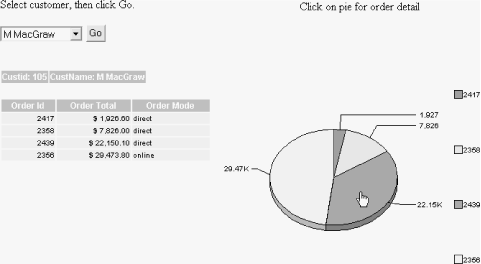12.1 Reporting
| Of the tools that business analysts and executives need, reports are the least glamorous but the most often accessed. Analysts sometimes prefer to avoid reporting software if that software requires help from the IT staff, especially if the process of creating and deploying the reports is more time-consuming and less flexible than manipulating the data directly would be. On the other hand, prebuilt reports often appeal to executives because they require no special IT skills or knowledge to view them. As web-based report generation has become commonplace, the distribution of such reports within an organization has been greatly improved. Users now need be familiar with only a browser. The OracleAS Reports Services components in Oracle Application Server include the following:
Multiple Reports Engines can be associated with a Reports Server instance, and you can have more than one server if you need them for load balancing and availability. Reports can leverage multiple data sources; these include the Oracle database via SQL or PL/SQL, the Oracle Database OLAP Option, Oracle Express, XML, JDBC, and text sources. For example, a report might be generated using SQL queries that leverage analytics in the Oracle database (inverse percentile, hypothetical ranking, etc.). You can also leverage data sources not supported out-of-the-box by programming to a Java API called the Pluggable Data Source (PDS) API. 12.1.1 Report Generation and DeploymentOracle Reports has a wizard-based frontend called Oracle Reports Developer that can build reports. Oracle Reports Developer is part of the Oracle Developer Suite. The reports created with Oracle Reports Developer can be deployed to the Web using OracleAS Reports Services support in Oracle Application Server. Developers can use the Oracle Reports wizards to step through the process of defining Reports structures, sources of data, break groups, and summaries. A page frame model enables a variety of formats. A Live Previewer displays report layout and a page of data after the initial format selection. The product provides re-entrant wizards to allow further modifications. Available formats include tables, matrixes , grouped reports, graphs, and combinations. You can add graphs to reports through a graphing wizard that features more than 50 different graph types. The graphs in Oracle's tools are built as "Presentation" Java Beans that enables common graph types among each Oracle business intelligence tool. The major supported graph categories include the following:
Figure 12-1 shows a typical report generated by Oracle Reports with an associated graph. Reports deployed for web use can be specified at runtime to be output in a variety of formats, such as PDF, plain text, HTML, HTML extension, or Cascading Style Sheets (HTMLCSS). By default, PDF output from Oracle Reports is compressed. Figure 12-1. Oracle Reports' typical report with associated graph You can also produce reports in formats more commonly used for printing, such as RTF or PostScript, or in data-oriented formats such as XML or delimited text. Multi-byte character support exists for HTML, PostScript, and PDF. You can use JSP-based Web Source Reports to create highly customizable and flexible tagged output formats such as HTML and XML. Using JSPs offers a number of advantages, including:
JSP-based web reports can be created from within Oracle JDeveloper. Version control during the development of reports and impact analysis is provided via the Software Configuration Manager in the Oracle Developer Suite. You can direct a report to a number of different destinations ”for example, to files, WebDAV URLs, printers, email destinations, and FTP destinations. You can use an XML distribution file to name the report destinations. Other report destinations can be created using the Pluggable Destination Java API for Report Engines. You can also deploy reports of any format to OracleAS Portal. The JSP capabilities in Oracle Reports enable deployment as HTML if you decide to use them as portlets. This capability allows you to publish web-based reports with dynamic access to data as it is changed in the database. Web-based reports can include predefined drill-down capabilities, which allow a business analyst to ask for more detail about a particular portion of a report. PL/SQL is used as the procedural language in Oracle Reports, but a Java bridge enables the import of Java classes. Oracle Reports supports advanced security features such as OracleAS Single Sign-On (which uses the Oracle Internet Directory) and fine-grained access control. These features ensure that only analysts with proper access rights can see specific reports. The reports themselves can be created in various customized forms for users or groups of users. These can be created using customization files that have XML tags to apply against the specific report version. Some businesses may want to use a single report as a distribution source for different reports, which can lower overall overhead for the combined set of reports. This technique, known as bursting , allows a report to be split up based on reporting groups (such as departments) within the report. For example, you may want to split a report into separate files (such as PDF files) and distribute specific department information to those departments via email. In some cases, you may want to generate reports in reaction to specific business events. Oracle Reports provides an Event-Driven Publishing API that's available as a PL/SQL package. Report "jobs" are submitted via HTTP. Reports in these jobs are then published when triggered by specific database events or by Oracle's AQ query mechanism. The Web Services interface to the OracleAS Reports Server in Oracle Application Server 10 g also enables integration into Java applications. |
EAN: 2147483647
Pages: 120